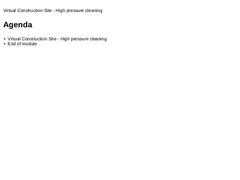
|
|
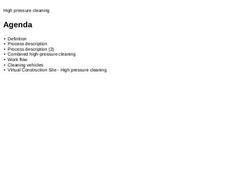
|
|
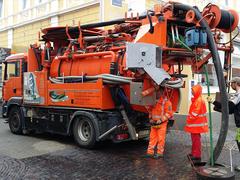
|
Depending on the boundary conditions, different types of vehicles are used for high-pressure cleaning. This module provides a detailed overview of the cleaning vehicles and familiarises you with the central process sequences and the diverse vehicle technology. After completing this module, you will have a sound knowledge of: - cleaning vehicle components and how they work;
- cleaning process flows; and
- operational restrictions.
|
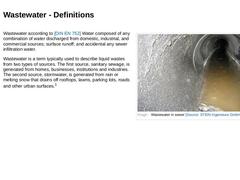
|
Wastewater according to [[DIN EN 752]] Water composed of any combination of water discharged from domestic, industrial, and commercial sources; surface runoff; and accidental any sewer infiltration water. Wastewater is a term typically used to describe liquid wastes from two types of sources. The first source, sanitary sewage, is generated from homes, businesses, institutions and industries. The second source, stormwater, is generated from rain or … |
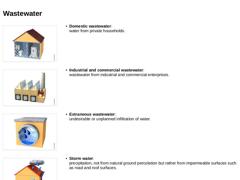
|
(Image: Domestic wastewater) (Image: Industrial (commercial) waste water) (Image: Infiltration of extraneous water) |
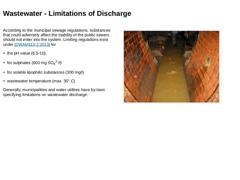
|
According to the municipal sewage regulations, substances that could adversely affect the stability of the public sewers should not enter into the system. Limiting regulations exist under [DWAM115-2:2013] for -
the pH value (6,5-10),
-
for sulphates (600 mg SO42-/l)
-
for volatile lipophilic substances (300 mg/l)
-
wastewater temperature (max. 35° C).
Generally, municipalities and water utilities have by-laws specifying limitations on wastewater discharge. |
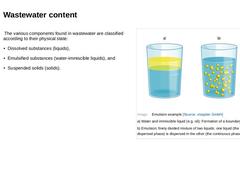
|
The various components found in wastewater are classified according to their physical state: -
Dissolved substances (liquids),
-
Emulsified substances (water-immiscible liquids), and
-
Suspended solids (solids).
(Image: Emulsion example) |
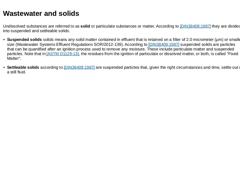
|
Undissolved substances are referred to as solid or particulate substances or matter. According to [DIN38409:1987] they are divided into suspended and settleable solids. |
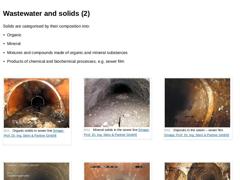
|
Solids are categorised by their composition into: -
Organic
-
Mineral
-
Mixtures and compounds made of organic and mineral substances
-
Products of chemical and biochemical processes, e.g. sewer film
(Image: Organic solids in sewer line) (Image: Mineral solids in the sewer line) (Image: Deposits in the sewer – sewer film) (Video: Organic and mineral deposits in the sewer line) Video: Organic and mineral deposits in the sewer line [Prof. Dr. Ing. Stein & Partner … |

|
|
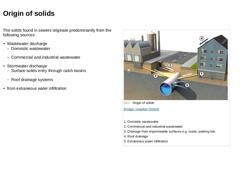
|
The solids found in sewers originate predominantly from the following sources: -
Wastewater discharge
-
Stormwater discharge
-
Surface solids entry through catch basins
-
Roof drainage systems
-
from extraneous water infiltration
(Image: Origin of solids) |
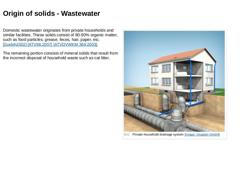
|
Domestic wastewater originates from private households and similar facilities. These solids consist of 80-90% organic matter, such as food particles, grease, feces, hair, paper, etc.
[Godeh2002] [ATV96:2007] [ATVDVWKM 369:2003]. The remaining portion consists of mineral solids that result from the incorrect disposal of household waste such as cat litter. (Image: Private household drainage system) |
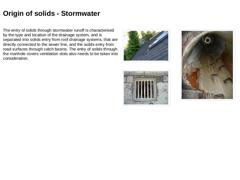
|
The entry of solids through stormwater runoff is characterised by the type and location of the drainage system, and is separated into solids entry from roof drainage systems, that are directly connected to the sewer line, and the solids entry from road surfaces through catch basins. The entry of solids through the manhole covers ventilation slots also needs to be taken into consideration.
(Image: Roof drainage) (Image: Storm drain - catch basin) |
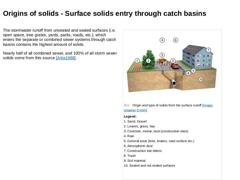
|
The stormwater runoff from unsealed and sealed surfaces (i.e. open space, tree grates, yards, parks, roads, etc.), which enters the separate or combined sewer systems through catch basins contains the highest amount of solids. Nearly half of all combined sewer, and 100% of all storm sewer solids come from this source [Artie1988]. (Image: Origin and type of solids from the surface runoff) |
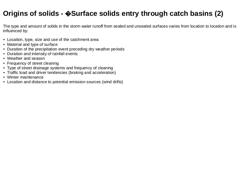
|
The type and amount of solids in the storm water runoff from sealed and unsealed surfaces varies from location to location and is influenced by: -
Location, type, size and use of the catchment area
-
Material and type of surface
-
Duration of the precipitation event preceding dry weather periods
-
Duration and intensity of rainfall events
-
Weather and season
-
Frequency of street cleaning
-
Type of street drainage systems and frequency of cleaning
-
Traffic …
|
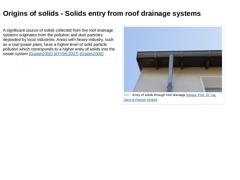
|
A significant source of solids collected from the roof drainage systems originates from the pollution and dust particles deposited by local industries. Areas with heavy industry, such as a coal power plant, have a higher level of solid particle pollution which corresponds to a higher entry of solids into the sewer system [Godeh2002] [ATV96:2007] [Godeh2000].
(Image: Entry of solids through roof drainage) |
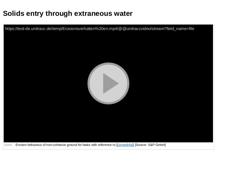
|
(Video: Erosion behaviour of non-cohesive ground for leaks) Video: Erosion behaviour of non-cohesive ground for leaks with reference to [Jones84a] [Image: S&P GmbH]. This interactive object is only visible in the online version of the module. |
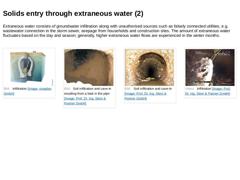
|
Extraneous water consists of groundwater infiltration along with unauthorised sources such as falsely connected utilities, e.g. wastewater connection in the storm sewer, seepage from households and construction sites. The amount of extraneous water fluctuates based on the day and season; generally, higher extraneous water flows are experienced in the winter months. (Image: Soil infiltration and cave-in resulting from a leak in … |
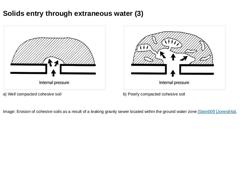
|
(Image: Well compacted cohesive soil [Jones84a]) a) Well compacted cohesive soil (Image: Poorly compacted cohesive soil [Jones84]) b) Poorly compacted cohesive soil Image: Erosion of cohesive soils as a result of a leaking gravity sewer located within the ground water zone [Stein00f] [Jones84a]. |
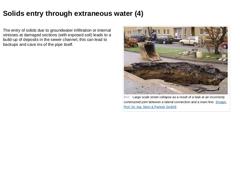
|
The entry of solids due to groundwater infiltration or internal stresses at damaged sections (with exposed soil) leads to a build-up of deposits in the sewer channel, this can lead to backups and cave ins of the pipe itself. (Image: Street collapse as a result of a pipe leak) (Video: TV-Befahrung eines Kanals - massive Ablagerungen) |
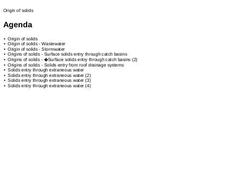
|
|
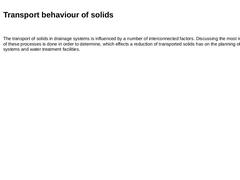
|
The transport of solids in drainage systems is influenced by a number of interconnected factors. Discussing the most important parts of these processes is done in order to determine, which effects a reduction of transported solids has on the planning of sewer systems and water treatment facilities. |
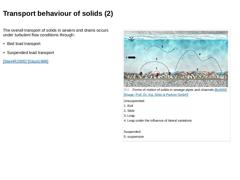
|
The overall transport of solids in sewers and drains occurs under turbulent flow conditions through: -
Bed load transport
-
Suspended load transport
[SteinR2005] [Glazi1989]
(Image: Forms of motion of solids in sewage pipes and channels) |
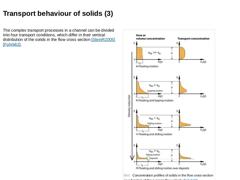
|
The complex transport processes in a channel can be divided into four transport conditions, which differ in their vertical distribution of the solids in the flow cross section [SteinR2005] [Führb62].
(Image: Concentration profiles of solids in the flow cross-section as a function of the average flow velocity) |
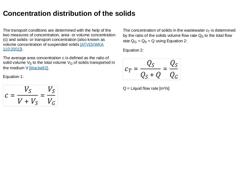
|
The transport conditions are determined with the help of the two measures of concentration, area- or volume concentration (c) and solids- or transport concentration (also known as volume concentration of suspended solids [ATVDVWKA 110:2001]). The average area concentration c is defined as the ratio of solid volume VS to the total volume VG of solids transported in the medium V [Macke82]. Equation 1: (Formula: Konzentrationsverteilung der Feststoffe) |